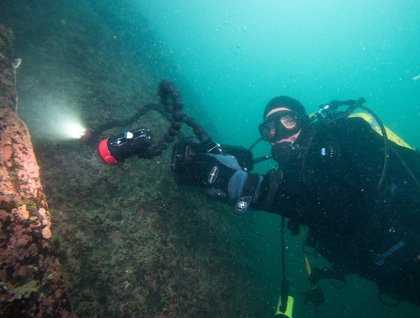Low gray clouds hung along the vertical granite walls. Spruce trees perched precariously on impossibly steep stone walls. How can they subsist in such a vertical world? Icebergs became increasingly more abundant as we wound our way towards the progenitor of scenic beauty, Dawes Glacier. Low wispy clouds added dimension and layers to an already stunning landscape. A fresh face showing from numerous calving, the glacier seemed to be lit from within by diffuse azure light. The sounds of icebergs popping and cracking reverberated along the fjord’s walls, interspersed with airborne notes from arctic terns and whines of newly born, shy harbor seals. For a handful of hours, Dawes glacier humbled us with raw beauty and unfathomable power.
Leaving the major icebergs and their fountainhead behind, we eventually came upon a legendary inlet within Tracy Arm Ford’s Terror Wilderness, the namesake Ford’s Terror. Containing a large basin, a narrow constriction point, and large tidal swings, Ford’s Terror has all the right ingredients for amplifying currents, creating standing waves and whirlpools. Arriving near a slack tide is integral for our afternoon expedition landing craft cruises, but even more important for my favorite activity: diving. After several years observing the water’s movements and tendencies, today was the day when the last excuse ran out and it was time to dive.
Purser Shawn and I built a dive plan and the site looked calm, just as I had hoped and expected with the current tidal conditions. However, tides change quickly in Southeast Alaska, so our window was a relatively narrow one. To our surprise, visibility exceeded expectations while water temperatures were, sadly, just as we presumed. Situated less than 15 miles from a glacier, it’s no surprise that temps hovered just above 40 degrees. The rain-washed rock face above continued below at a consistent angle, making for an easy descent. For every one horizontal foot, the wall fell off another ten. Searching the wall for life, we found an incredible number and diversity of shrimp, most of them tending to a patch of algae surrounded by encroaching purple coralline algae. Shrimp popped off the bottom like popcorn suspended in midair, yet something more peculiar caught my eye. Resembling a swimming golf ball, Pacific spiny lumpsuckers were spotted all over the short stretch of wall we surveyed. With pelvic fins adapted to grasping and clinging, they are well adapted to life in the strong currents of Ford’s Terror. Although they may seem comical and inept, these fish are able to clasp onto the smooth rocks with surprising force. As our hands began to get cold and with the threat of a building tide in the back of our minds, I suddenly envied the little lumpsucker. There’s no way I would last in these tumultuous waters, yet the lumpsucker thrives here. Clutching their granite throne in a rushing spring tide with 10 knots of current ripping past them, they transform from clown to sentinel.







